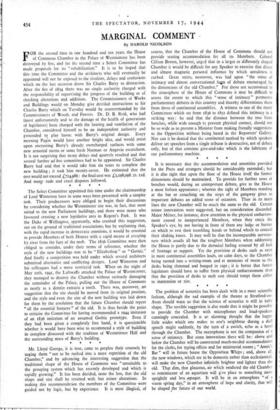The Select Committee appointed this time under the chairmanship of
Lord Winterton have in some ways been presented with a simpler task. Their predecessors were obliged to begin their discussions by considering whether the Westminster site was, in fact, that most suited to the new Parliament buildings, and there were many who favoured creating a new legislative area in Regent's Park. It was the Duke of Wellington, apparently, who crushed this suggestion, not on the ground of traditional associations, but by explaining that, with the rapid increase in democratic emotions, it would be essential to provide Members of both Houses with a rapid means of escaping by river from the fury of the mob. The 1836 Committee were then obliged to consider, under their terms of reference, whether the style of the new buildings was to be " Elizabethan" or " Gothic." And finally a competition was held under which several architects submitted alternative and conflicting designs. Lord Winterton and his colleagues had a more restricted task. When on the night of May loth, 1941, the Luftwaffe attacked the Palace of Westminster, they managed to destroy the Chamber without seriously damaging the remainder of the Palace, pulling out the House of Commons as neatly as a dentist extracts a tooth. There was, moreover, no suggestion that the site should be moved from its original position, and the style and even the size of the new building was laid down for them by the resolution that the future Chamber should repeat "all the essential features" of the old. It is thus beside the point to criticise the Committee for having recommended a 1944 imitation of an 1836 imitation of an assumed Gothic prototype. Even if they had been given a completely free hand, it is questionable whether it would have been wise to recommend a style of building in complete disaccord with the tradition of Westminster Hall and the surrounding mass of Barry's building. * * * *


























 Previous page
Previous page